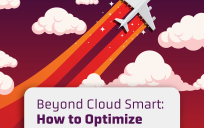Cloud computing has transformed and touched almost every aspect of government. However, many agencies still struggle to effectively adopt cloud because of systemic roadblocks and user misunderstandings. Despite these barriers, agencies are moving forward on cloud adoption and are looking for a clear path to prepare, plan, and execute cloud computing strategy.
GovLoop’s recent in-person training, “An Agency’s Journey to the Cloud,” worked to clarify some of the confusion surrounding cloud computing strategy and offer a clear direction moving forward. Its second keynote speaker, James Jones, gave a presentation titled “Insights into How the Cloud Really Works at DoT.” As a PMP, Management/Program Analyst in the Office of the Chief Technology Officer at the Department of Transportation, Jones offered an insider perspective on the progress DoT is making in adopting and embracing the cloud.
Jones emphasized that DoT is actively focusing their cloud strategy on five key aspects:
- Links to Office of the Chief Information Officer’s Strategic Plan: ensuring an enterprise approach to cloud adoption and working to integrate cloud computing into the larger strategic plan.
- Cloud Inventory: acknowledging what DoT has already done with cloud computing and aligning this progress with the long-term road map leading to the cloud.
- Collaborating with the Modes on Cloud Moves: confirming that all departments, or modes, within the DoT are on the same page and working together to move forward rather than wasting time, money and effort by not collaborating.
- Ensure the Chief Information Officer’s team is involved: working with the CIO’s office ensures security, privacy, governance, and shared services are driven by efficiency.
- People, Processes and Technology: making sure every aspect of the cloud strategy is on the same page.
Through their cloud strategy, DoT established a process for joining the cloud. Jones explained, “migration to the cloud is evolutionary, not revolutionary.” He emphasized that not everything should move to the cloud – the goal of the process is to move only appropriate applications and services. As a result, migration to the cloud is done in stages and often by individual projects or applications.
For example, DoT is working on specific initiatives and projects tied to the cloud. These include infrastructure upgrades, using data as a service, consolidation, and overall IT modernization. Jones explained that these initiatives address long-term planning for the department while simultaneously making processes easier, cheaper, and faster.
However, cloud migration has not come without its challenges for the DoT. Some of these challenges include communication, commitment, security privacy, education, and collaboration. Jones noted that getting individuals to commit is one of the biggest challenges as cloud migration is such a large undertaking. People are also often hesitant to commit because they are not educated about the cloud and they are scared of the unknown. But Jones stressed that, “cloud has become part of our culture today.” As a result, agencies must push through these challenges and move forward in cloud migration.
DoT’s cloud migration is a work in progress but it is moving forward. Jones highlighted the three main things DoT is working on are bringing the different departments within DoT together to address cloud adoption; leveraging FedRAMP as a resource; and utilizing contracts already in place. Through this process, Jones is optimistic DoT’s journey to the cloud will continue to be a success.
For more information and tips on how your agency can successfully make the switch check out GovLoop’s recent guide, “Mapping Government’s Journey to the Cloud: 8 Success Stories.”





Leave a Reply
You must be logged in to post a comment.